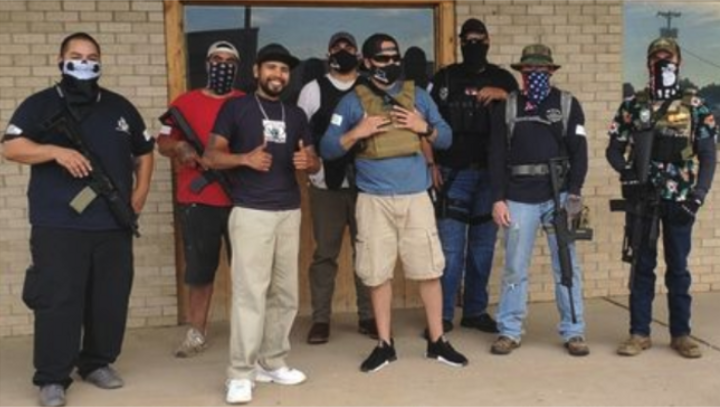Disrupting Violent Extremists’ ‘Free Spaces,’ Online and Off
Extremist groups like the New Mexico Civil Guard are benefitting from iterative recruitment in online and offline spaces that bridge ideologies.

Published by The Lawfare Institute
in Cooperation With

Editor’s Note: Domestic extremism today involves the mixing of many elements, making counterterrorism far more difficult. National Defense University’s R. Kim Cragin uses the case of the so-called New Mexico Civil Guard to explain how white supremacist and anti-government elements can interact in one organization. She also illustrates how groups use both virtual and physical spaces to organize themselves and plan attacks.
Daniel Byman
***
Several commentators have observed that the white power and anti-government movements have started to blend somewhat. For example, the "Unite the Right" rally that took place in Charlottesville, Virginia, in August 2017 was organized by well-known leaders of the white power movement but also was attended by anti-government militias. Journalists noted at the time that some participants wore militia and neo-Confederate patches on their clothes. This pattern has repeated itself since. As we try to understand how Americans become involved in violent extremism, we must acknowledge the fluidity between white power and militia movements. Equally important, we also need a better understanding of how these extremists take advantage of virtual and physical “free spaces,” where they can interact freely and without judgment, to recruit new members.
The self-described New Mexico Civil Guard (NMCG) exemplifies this fluidity. In June 2020, several hundred people gathered outside the Albuquerque Museum to demonstrate and advocate for the removal of a statue of the Spanish conquistador Juan de Oñate. This demonstration was not unusual. But it occurred in the midst of the Black Lives Matter (BLM) demonstrations and other protests against the public display of statues honoring Confederate figures, so the June 2020 event attracted counterprotesters, including the NMCG. Its members can be seen in videos of the protest carrying weapons and dressed in camo and tactical helmets with “NMCG” on them. It is also clear from the videos that the situation escalated quickly, culminating in a counterprotester shooting and critically injuring a protester. While NMCG members were not directly involved in the shooting, they contributed significantly to the overall chaos and escalation.
At the time of the protest, the NMCG was only three months old, but it had already accumulated 150 members. That’s a relatively fast rate of recruitment. The organization accomplished this by drawing members from existing white power and anti-government militia groups, as well as by capitalizing on both virtual and physical free spaces.
On March 12, 2020, three months before the de Oñate statue protest, Bryce L. Spangler (aka Bryce Provance) created the NMCG Facebook page. According to press interviews, Spangler intended to use the NMCG to protect private property in the wake of the BLM protests. Two days later, on March 14, Spangler posted a call-to-arms or “muster” on the Facebook page. This muster invited potential volunteers to gather in person and sign up for the NMCG:
The purpose of this muster is to summon, organize, and train the Militia of NM. The role of the Militia is to defend the Constitution of the United States, the laws, the property of and the citizens of NM and the United States of America and above all to serve our neighbors in any time of need[.]
Spangler had a history of involvement with the white power movement prior to creating the NMCG, specifically with neo-Nazi skinheads. But not all of the NMCG’s members came from this movement. This can be seen in NMCG social media. The NMCG was divided into several different geographic “companies,” each overseen by a different person. These so-called company commanders maintained their own Facebook pages. Each company page provides insight into the variety of worldviews held by NMCG members. Curry Company featured boogaloo movement iconography on its page, while Bernalillo Company displayed images associated with the Three Percenters. Others reflected ties to the Proud Boys. The NMCG clearly felt welcoming to members of both the white power and anti-government militia movements.
Having created the NMCG, Spangler and his so-called company commanders used social media to promote their ideas and attract new members. But the NMCG did not rely solely on social media for its recruitment. They also sponsored in-person field training events. These events often combined social activities, such as barbeques, with weapons training. Sometimes these were only for NMCG members, but at other times NMCG trained with friends or neighboring militias. Once individuals joined the NMCG, Spangler and his company commanders, in turn, used social media to mobilize NMCG members to participate in rallies and counterprotests. Then, at the rallies, NMCG members would take the opportunity to identify and approach prospective new recruits in person.
This iterative pattern of recruitment—virtual spaces, physical spaces, virtual spaces—is not unique to the NMCG. Adam Fox and Barry Croft also recruited men from both virtual and physical free spaces for the October 2020 plot to kidnap Michigan Gov. Gretchen Whitmer. The 15 men arrested for the plot—seven of whom have been convicted for their roles—came from the Boogaloo Bois, Three Percenters, and Michigan Militia. Some were discovered by Fox and Croft through the Wolverine Watchmen Facebook group. Others met at rallies against coronavirus restrictions. Fox and Croft also used a combination of weapons training, surveillance activities, and regular communications over encrypted apps to solidify members’ commitment.
The NMCG and Wolverine Watchmen illustrate that demarcation between white power and anti-government free spaces is permeable. Further, violent extremists have developed methods of using virtual and physical free spaces to reinforce each other as they recruit new members. While it is important to mitigate the spread of violent extremism in virtual spaces, it is simply not enough. Counterextremism efforts should incorporate ways of breaking up the iterations or making the spaces that are available for organizing and recruitment, both on and offline, fewer and further between.
Fortunately, successful examples of this approach exist. In July 2020, soon after the de Oñate statue protest, the district attorney of New Mexico’s Bernalillo County filed a civil complaint against the NMCG and 14 of its members. The complaint argued that New Mexico law forbids the formation of unregulated paramilitary groups and that the NMCG was in violation of the law because it presented itself as an adjunct to the state’s military. This civil complaint occurred in tandem with efforts by Facebook to shut down the pages of multiple paramilitary groups, including the NMCG. In October 2022, a judge agreed and issued an injunction against the NMCG, prohibiting the group from organizing or operating in public.
The local government’s response to the NMCG is a potential model for those interested in minimizing the recruitment of individuals by domestic violent extremist groups. Critically, the response combined efforts to minimize the NMCG’s outreach in both virtual and physical spaces. It was also reinforced by the precedent set by another successful lawsuit against three militias with members present at the 2017 Unite the Right rally. These lawsuits, combined with other efforts in virtual spaces to challenge extremism, demonstrate that it is possible to disrupt violent extremists’ use of physical and virtual spaces to recruit new members. Policymakers just need to commit to pursuing these groups with all the tools available.





